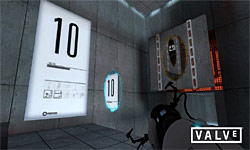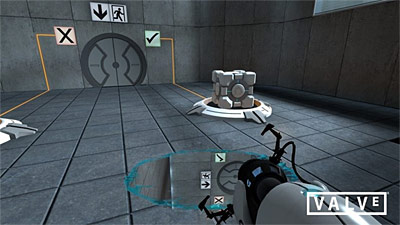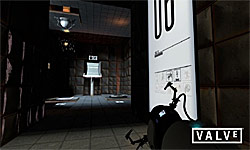Welcome to Aperture Science
For all intents and purposes, Valve’s Orange Box – a game combo that included Half-Life 2, its two subsequent episodes, Team Fortress 2, and Portal – was supposed to be more of a packaging showcase rather than putting any single entry on a gaming pedestal. It was meant as a consumer-oriented value proposition led by the strength of the Half-Life brand and tapping into nostalgia for the classic Team Fortress. Yet, it was the little-title-that-could – Portal, that garnered the most critical attention.

Developed by a group of students at the DigiPen Institute of Technology, Portal went from under-the-radar to Orange Box centerpiece. Instead of people reserving it as the last stop on their Orange Box tour, they made it their first. 2007 became the year of Portal in-jokes on message boards and among gamers. It seemed like people were always mentioning the “cake is a lie” and waxing poetic about the heart-shaped Companion Cube.
Portal: Still Alive strips the original Portal from the Orange Box, allowing it to bask in its own dedicated glow. New to this downloadable version (available at 1,200 MS Points) are stat tracking features and 14 levels from Portal: The Flash Version originally developed by the group We Create Stuff. If you missed Portal the first time around, this is the version to get and for those that already have the Orange Box, it provides plenty of new challenges to justify the price tag.
Students of behaviorism should be familiar with the operant conditioning box (also known by the name Skinner Box on account of its creator, B.F. Skinner). You place an organism in an enclosed area, blocking stimuli from the outside (like light and sound), so that only selected forms of stimuli can be directed at the quarantined subject. There’s usually some kind of incentive to keep the subject reacting – the most common example is a rat rewarded with pellets from a feeder. Portal takes this bit of psychology and twists it to its own end: you’re the rat, stuck in a series of Skinner Boxes and instead of pellets, there’s the promise of cake, plus grief counseling (the first note of the game’s sense of humor).

The deliverer of this promise is GLaDOS (voiced by Ellen McLain), the A.I. that watches over Aperture Science, a direct competitor to Gordon Freeman’s employer: Black Mesa. One chamber at-a-time, GlaDOS slowly lays out the rules of the world. It’s all handled in a very well-paced manner. You’re first taught about the nature of portals – teleporting pockets that allow you to traverse from one area to another – and then given a gun that allows you to create your own. By shooting an orange portal, you set up a point of departure, and once a blue portal is laid down, you have an exit. One-by-one, more elements are introduced. You learn to use weighted cubes to hold down switches and how to direct energy orbs into receptacles to unlock doors.
Again, it’s the way that Portal handles introducing all these elements that makes it so successful. Even though the laws of physics are being bent, at no point is it hard to wrap your mind around the concepts on display. When you first learn that you can use momentum to rocket yourself from one portal to another, a light bulb goes off, making you say, “Why didn’t I think of that already?” True to her tongue-in-cheek nature, GlaDOS lays out the process, saying, “Momentum: A function of mass and velocity conserved between portals. In layman’s terms, speedy thing goes in, speedy thing comes out.”

Yet all is not well – a slightly sinister tinge is added to the way GLaDOS delivers her lines as the games progresses. It’s not just the dialogue: you’ll notice that the while the objectives are the same (escape each test chamber), the obstacles are more deadly. What were once safe pits, composed of tiles, are later filled with acid; hallways are marked by sentry turrets; and giant mechanical compressors will raise you up one moment, only to try and squash you the next. This sudden increase in environmental danger is compounded by cryptic signs left by previous test chamber subjects: such as bloody hand prints and demented scribblings etched into walls just off the beaten path.
Like Braid, Portal is all about culmination. The last level and ending flip the initial, objective-to-objective plot around, not only giving you a better appreciation for the conclusion, but also of everything you played up to that point. It also sheds a little bit of light onto the seemingly secretive nature of Valve’s Half-Life world.

Stopping there takes us through Portal. Still Alive includes 14 new levels that throw you back into a series of Skinner Boxes. Whereas the original Portal had a more organic feeling to puzzle solving – if you stopped to think for a few minutes, you could get out of any situation – Still Alive takes a more stubborn approach. This is not entirely negative, but mentioned merely to illustrate a point of departure; Still Alive assumes you’ve finished Portal, so it extends and amplifies the difficulty curve, instead of resetting it.
From the second level on, it’s apparent that the straightforward puzzle approach present in Portal has been traded in for a more hardcore mindset – you’ll get things done, but you’ll rely more on intricate portal acrobatics and extremely well placed shots that barely fly through shoe box-sized holes connecting walls. There’s also some new environmental variables at play: red laser nets scorch anything they come in contact with; malfunctioning electric grids let out a deathly sizzle; and ceilings lined with giant spikes attempt to crush you. The nice thing about these new additions is they feel like they fit in the Portal universe – not like someone threw a random assortment of props on a closed set – and force you to stop and think before you take a course of action.
Still Alive may nail set design and its respective dressing, but it’s missing one element that was crucial to the original: personality. GlaDOS is nowhere to be heard, so there’s no comic relief to be found. With no stimuli – besides the puzzles themselves – it makes for a very solitary experience. Also, chambers aren’t really connected, so every time you finish one you’re booted to a main menu and have to select the next one. This isn’t that big a deal, but it does break a sense of continuity. Once you find the stat tracking tools, it’s clear the hardcore mentality mentioned earlier is the primary design factor behind the test chambers. Each time you play a test chamber, your total number of portals and steps taken are recorded. Achievements are given out based on cutting these down to an extremely small number.
Portal’s blend of first-person, action, and puzzle elements marked by wry psychology and facetious dialogue make for a one-of-a-kind experience. Bolster this package with Still Alive’s 14 new, more difficult levels and this is a game that shouldn’t be missed.
RATING OUT OF 5 RATING DESCRIPTION 4.2 Graphics
Even with a few years under its belt, Valve’s Source engine still impresses. The frame rate is rock solid and load times are even faster than the Orange Box version (thanks to the dedicated space on your 360 hard drive). 4.5 Control
Acclimation is not a problem: you’ll pick up the controls quickly and be sailing through portals with relative ease in no time. 4.5 Music / Sound FX / Voice Acting
The score takes a minimalist approach and it comes off well, with the rare bits of music utilizing crescendo at just the right moments. Then there’s GLaDOS – her digitized remarks lend to some great comic moments. Oh, and there’s the now-classic end track: “Still Alive” by Jonathan Coulton. 4.7 Play Value
It’s a repackaged version of one of last year’s best games with newer, tougher puzzles. If you missed out on the original, this is the version to pick up. 4.5 Overall Rating – Must Buy
Not an average. See Rating legend above for a final score breakdown.
Game Features:
